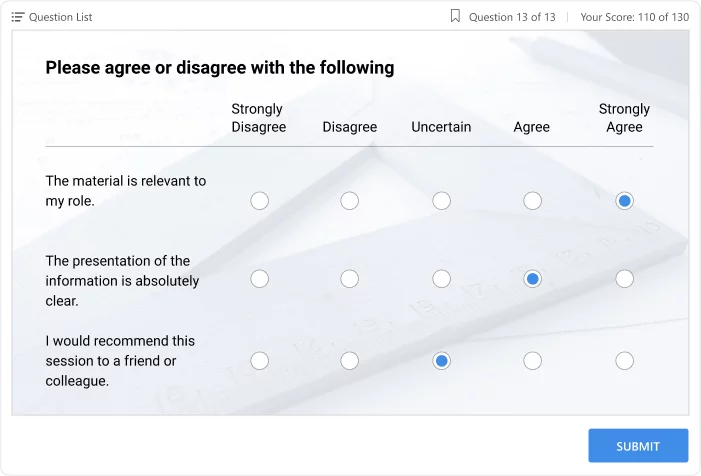18 Training Activities and Games: Best Ideas and Examples

Every HR and L&D professional knows that even after doling out hundreds of thousands of dollars annually for professional training programs, any lecture or session that doesn’t leave much room for interactivity loses its punch. The desire to increase learning effectiveness motivates companies to focus on engaging employees during L&D activities.
Whether you prefer instructor-led training or the eLearning format to achieve your learning objectives, in this article, you’ll discover some of the most effective corporate training activities and games to help you build a successful training program.
What Are Training Activities?
A training activity is any structured exercise or task aimed at achieving certain predefined learning goals and objectives. Some examples are workshops, seminars, webinars, and debates. While a training activity may include some interaction between participants, it is not a strict requirement for this type of exercise.
What Are Training Games?
A training game, on the other hand, is also a structured exercise with predefined goals and objectives, just like any training activity. But unlike other similar employee training activities, training games have a stronger focus on interactivity, plus they also may include an element of competition.
Training activities vs. training games
As a rule, games are more challenging and fun to participate in than other training session exercises, which makes them ideal for boosting learner motivation. Besides, training games also come in handy when you need to create a more relaxed atmosphere during a session. For example, there will most certainly be lots of laughs as employees try to construct a marshmallow tower or untangle a human knot.
Thus, all training games can also be considered training activities, but not all activities used in training sessions are games. Whatever type of activity you choose, there are multiple reasons for including these exercises in your training and development programs. Let’s take a closer look.
Why Use Training Activities and Games During Training Sessions
Being more experiential, all training activities, especially games, are instrumental in helping learners put theory into practice and encouraging a more hands-on approach to skills development.
Today, training activities and games are widely used in training and development programs in a variety of settings. Particularly, these exercises are very popular in both on-the-job and online corporate training. That’s because they have proven their effectiveness in developing not only hard skills but also crucial soft skills, such as communication and collaboration. Plus, they’re great for team building.
For example, by including interactive training ideas in your programs, you can encourage participants to collaborate to help each other achieve a common goal, which is something every team needs to do in an actual business environment.
On the other hand, there are types of training and development activities that promote crucial skills, such as problem-solving or self-assessment, as with case studies and quizzes.
And don’t forget educational materials like slide courses and training videos that are particularly well-suited for self-paced learning, which is a crucial part of all education in general and corporate training in particular, especially in the post-pandemic world.
And these are not assumptions: the significance of incorporating such exercises into L&D programs is backed by science. As per the cognitive-experiential self-theory (CEST), there are two ways that the human brain processes and retains information: analytical-rational and intuitive-experiential. Both are important, and they should work in concert to provide the best possible result.
By combining different types of training exercises in their training and development programs, businesses can activate both rational and experiential learning, significantly improving their employees’ performance in their roles. Moreover, these exercises can increase staff loyalty and build better, more engaged teams.
Depending on the training goals and the specifics of your business, you can use different approaches and combine them if and when necessary. For example, you can add a simulation game to your self-paced online course and use the human knot during on-the-job training sessions as a team-building exercise. Moreover, you can include these exercises in your blended learning programs, offering your employees the best of both worlds.
Below, you’ll find a selection of popular training activities for employees, including instructor-led and eLearning activities, plus several training games that have proven their effectiveness time and again.
The Top 6 Instructor-Led Training Activities
Instructor-led training (ILT) is synchronous training in which an instructor, either in person or virtually (VILT), conducts a class. ILT happens in real time, allowing for immediate feedback and interaction between the instructor and learners.
However, this approach tends to be less flexible, as training sessions depend on the trainer’s schedule, venue availability (if conducted in person), and other factors. However, if bringing multiple employees together at the same time is not an issue for you, these corporate training activities are definitely worth considering:
1. Workshops
Workshops are hands-on meetings, as opposed to lectures or presentations that primarily consist of listening to a speaker. They are led by an instructor or facilitator as well, but encourage collaboration and teamwork, often requiring participants to break into small groups to solve problems, brainstorm ideas, and develop solutions. Such a format fosters a sense of community and mutual learning among the members of the team. Depending on the goal, such meetings can last a couple of hours or even a few days.
Workshop example
In a corporate setting, a workshop might focus on various themes. For example, a workshop on project management could involve a simulated project where attendees have to plan, execute, and then review their performance, providing valuable insights into how to manage real-world projects effectively.
2. Debates
Unlike workshops, where the emphasis is often on collaboration, debates fuel critical thinking through argumentation and counter-argumentation, and also boost presentation skills. Participants are divided into teams and presented with a topic or problem to argue for or against.
It’s becoming more common for good ideas to come from everyone in the organization, not just top management. Instead of just having a suggestion box, encouraging debates allows employees at all levels to brainstorm. During debates, the team might arrive at unexpected conclusions that can help make informed decisions on mission-critical projects.
Debate example
If the company is launching a new product, teams could debate various go-to-market strategies. This could include discussions on pricing plans, target audiences, and promotional tactics.
3. Peer-to-peer learning
Peer-to-peer learning, or peer-to-peer training, is a type of training where employees in an organization share their knowledge and experience on a given subject. Typically, the participants of peer learning sessions work within the same department or at the same level within a company.
This approach not only enhances each learner’s knowledge on given subjects but also promotes collaboration, helps colleagues get to know each other better, and saves money for the company. In 2024, peer-to-peer learning was among the leading components of workplace training in the US, which highlights the widespread adoption and significance of this practice.
Peer-to-peer learning example
During sessions, peers may give presentations on pre-assigned topics relevant to their work duties and afterward engage in group discussions on these topics.
For example, a software development department may organize a peer-to-peer training seminar in which specialists who have recently learned a new framework will share their experiences and insights with their colleagues. This training activity will help the entire team become updated with the latest practices in the department.
4. Cross-training
Cross-training, or cross-departmental training, is the practice of teaching employees the knowledge and expertise that are outside of their core work. Instead of specializing in just one job, employees learn how to perform various tasks, making them more versatile. Cross-training helps employees realize the other team members’ contributions to company goals and also ensures a seamless workflow when an employee takes a vacation. According to the previously mentioned research, cross-functional training is also one of the most common corporate training practices.
Such training can be considered a form of ILT when it’s conducted under the guidance of an expert or instructor. However, it’s worth mentioning that cross-training can also be conducted through other methods, such as eLearning courses or on-the-job training, depending on the organization’s resources and needs.
Cross-training example
In the healthcare sector, a nurse might be cross-trained to perform administrative duties, enhancing the workflow during busy times or staff shortages. In manufacturing, a machine operator might be cross-trained to handle basic maintenance tasks for the equipment they operate. This ensures that minor issues can be promptly addressed without having to wait for a specialized maintenance team.
5. Case studies
People learn better through real-world cases than through theories. In case studies, employees are usually given information about a specific challenge or situation, collaborate with a team member, and come up with potential solutions.
Unlike debates that can be based on hypothetical challenges, case studies reflect real-world situations that employees have faced or may face, equipping them with the tools and confidence to handle similar situations in their day-to-day work.
Case study example
In the customer service sector, a case study might illustrate how an exceptionally difficult customer complaint was handled while maintaining the company’s reputation. In the financial industry, a case study on a failing investment strategy could be analyzed to identify errors and propose alternative approaches.
6. Webinars
Webinars, or web-based seminars, are led by an expert or a trainer who usually uses slides, audio, and sometimes video to guide the participants through a specific topic or set of skills.
Webinars are especially useful for training remote teams or when you need to share knowledge across multiple locations. They offer a level of convenience that traditional methods may lack, allowing people to participate from anywhere they have internet access, without the need for travel or physical meeting rooms.
Webinar example
Companies might host a webinar to communicate significant organizational updates, such as policy changes, new regulations, or a corporate rebranding initiative, to all employees.
The Top 6 eLearning Training Activities
Unlike instructor-led activities, which are often more rigid because of the need to coordinate with a trainer, eLearning puts the learner in the driver’s seat. The key distinction between synchronous ILT and asynchronous eLearning lies in the fact that employees can choose when and where to engage with the material. This autonomy is particularly appealing to adult learners, who often have diverse responsibilities and prefer having control over their learning paths.
eLearning courses are one of the best training ideas for employees that businesses can implement. According to research, access to online resources was key to upskilling and reskilling, with 47% of US employees citing it as the main component of their workplace training in 2024.
Let’s cover some different eLearning activities that enhance employee engagement, such as:
1. Slide courses
Slide-based courses are the foundational format of eLearning activities. These are self-paced courses similar to PowerPoint presentations but enriched with interactivities, clickable buttons, multimedia elements, and possibly narrations. This interactivity transforms the passive viewing of training content into an engaging training experience.
Slide courses are great when you need to break down complex ideas into easily digestible chunks, allowing learners to focus on one concept at a time.
Slide course example
When creating slide-based courses, there are two pitfalls you’ll want to avoid. The first is building courses that feel like dull presentations, which will not engage participants. The second is spending long weeks crafting quality content. Fortunately, tools like iSpring Suite can help you overcome both of these challenges efficiently.
It’s a super easy course creation tool that works directly in PowerPoint and allows you to create attractive slide-based courses from scratch in a matter of minutes. Here’s an example of the kind of course you can create – even with no initial design or coding skills:
2. Quizzes
Quizzes are powerful and versatile tools in both the eLearning arsenal and during an in-person instructor-led training session. They can serve as diagnostic tools to assess the initial level of employee knowledge and skills. Mid-course quizzes can help reinforce learning and keep the momentum going, while final assessments can provide a comprehensive review and measure overall knowledge retention.
Unlike ILTs, where it’s the instructor’s responsibility to mark assessments and assign grades, eLearning courses are often equipped with automated grading capabilities and feedback for correct and incorrect answers. Also, online quizzes offer trainees insights into employee progress and areas where additional training is needed.
Quiz example
iSpring Suite offers 14 types of quiz questions, including multiple-choice, super-engaging drag-and-drop, hotspot, and sequence questions. Check out this example of an interactive quiz you can create with iSpring Suite:
3. Polling
While quizzes are often used to evaluate understanding, polls serve to collect opinions and preferences or gauge the pulse of the group on various topics. This activity encourages participants to share their thoughts openly, leading to a more inclusive and collaborative learning environment.
You can start a course with a poll to understand what learners hope to get out of the training. During the course, intermittent polls can be used to get feedback on the pace, the difficulty of the material, or even to choose which topic to cover next. This not only gives learners a sense of control but also allows instructors to tailor the course in real time based on the responses.
Polling example
You can create this multiple-choice poll with iSpring in a couple of clicks:

4. Training videos
Training videos are effective eLearning tools that cater to diverse learning styles, provide a break from text-heavy materials, and allow you to explain complex concepts in a more digestible format. In 2024, training videos were named the second most engaging training format by employees in the US, with 65% of respondents choosing this option over others.
This format gives employees the flexibility they need. Learners can watch pre-recorded video content whenever it fits into their schedule, making it easier to balance training with other responsibilities. They can also pause, rewind, or review the videos as often as needed, which supports better understanding.
Also read:
How to Create a Video for an Online Course
Talking Head Videos: A Comprehensive Guide on Video Production
Training video example
With iSpring Suite, you have plenty of opportunities to create training videos: they can be screencasts, video lectures, or even picture-in-picture videos that include talking head footage and presentation slides. You can take a look at one here:
5. Role-play simulations
Simulations bring the concept of learning by doing to a virtual environment, giving employees an opportunity to practice real-world scenarios. Being one of the most popular, effective, and fun activities for training sessions, they are also very adaptable and can be held during face-to-face training and led by an instructor, but eLearning simulations allow learners to navigate different situations at their own pace and explore the consequences of their choices in a controlled manner.
In essence, it’s a safe-to-fail environment for trainees, especially those in sales and retail, to elevate their communication skills without jeopardizing a sale or your organization’s reputation.
Also read: Retail Training Made Easy
Another benefit of this training activity is repeatability. Employees can go through simulations as many times as needed to fully understand the material or improve their skills without any additional cost or organizational effort.
Simulation example
Role-playing simulations might seem too complex to develop at first. But with iSpring Suite’s drag-and-drop interface, you don’t need coding or other tech skills. Moreover, the built-in Content Library offers tens of thousands of pre-designed characters and locations that allow you to create an immersive training atmosphere. Characters can change their poses and facial expressions depending on the learner’s response.
See how it works in this role-play dialogue created with iSpring Suite:
6. Mini tutorials
Mini tutorials aren’t very conducive to ILT because they involve training that’s delivered in bite-sized, easy-to-digest pieces. As such, each learning module is laser-focused and therefore aims to address a single question, problem, or learning objective.
They can be built in several formats, such as a game, slide course, podcast, or video. With microlearning, it’s not so much the method of content delivery as it is content organization. If you’re looking to maximize knowledge retention in the least amount of time, then this training activity is one of the winning employee training ideas you can choose.
Mini tutorial example
With an advanced subscription to iSpring Suite AI, you can easily create mini tutorials in the form of longreads with quizzes online, right in your browser. You only need to input text, images, and videos, as well as knowledge checks, if applicable. See how the mini tutorial might look:
The Top 6 Games for Training Sessions
As engaging as they are, the staff training ideas listed above are usually still perceived as more or less formal training. If you’re looking for something more creative and fun, you can’t go wrong with training games.
As mentioned earlier, games can serve as ideal activities for increasing learner motivation and collaboration, as well as creating a more easy-going atmosphere during a training session. Because training games have rewards like scores, points, and even prizes, they reinforce learning behaviors that lead to better knowledge retention and overall training results.
And besides, games promote using newly acquired as well as existing skills in a safe environment similar to a real-life situation that employees might encounter on the job. A gamified approach to training makes employees more engaged, facilitates onboarding, and improves employee productivity. According to data provided by Zippia, 90% of employees claim that gamification helps them be more productive at work, and 72% of people find gamification remarkably motivating, prompting them to do more tasks and work harder.
Here are some fun training ideas for employees you can use to complement your sessions.
- The pirate ship
- Scavenger hunt
- The snowball fight
- The human knot
- The marshmallow challenge
- Start, stop, continue
1. The pirate ship
The pirate ship is a so-called “icebreaker” training game. Icebreakers are activities that are typically used at the beginning of a session to establish contact, create the right atmosphere, and give participants time to get to know each other a bit better.
The pirate ship is one of the best-known icebreakers because it’s both fun and effective. In this exercise, participants are asked to imagine they’re the crew of a pirate ship. They’re presented with an image of a ship with crew members aboard and are asked to pick the member they would like to be. Then, they describe their character and explain why they picked it.
During a corporate training session, this fun activity is a great way to help trainees reflect on their personality traits, their desired and actual role in a team, and the ways they can contribute to the team. Plus, it doesn’t require any materials besides a single picture.
“The pirate ship” example
When a company organizes a session for a group of employees who don’t necessarily interact on a daily basis, the atmosphere in the room might initially feel a bit tense because nobody knows what to expect. In such a case, the pirate ship exercise would be an ideal “primer” to help participants relax, learn more about their colleagues, and gain some understanding of how they can work best as a team.
An added plus is that this activity works well in an online environment — it can be played in a chat session, for example.
2. Scavenger hunt
This is one of the most popular team games ever, so chances are you’re already familiar with it. In a nutshell, it’s an activity that involves retrieving several hidden items using the clues provided by game organizers — in the case of corporate training, by the instructor or facilitator.
The beauty of this game is that you can pick practically any topic you like, from a treasure hunt to a zombie apocalypse. Some of the fun training topics for employees include survivor challenges, various heists, espionage games, and more.
In a corporate setting, this beloved child’s game becomes a powerful tool for team building as well as for developing collaboration and problem-solving skills. With just a handful of materials, some planning, and imagination, you can design a fun, engaging activity to help the participants bond and encourage them to work as a team.
“Scavenger hunt” example
If you need to include an activity to promote collaboration in your session and also add an element of fun, just pick a topic relevant to your session or event. For example, when discussing sustainable practices, give the participants clues with riddles describing the most sustainable items in an office.
As the team solves the riddles, the employees will not only practice working together and using their pooled thinking skills to solve problems, but will also learn more about sustainability.
3. Snowball fight
This popular game is a classic snowball game with a twist. Besides being fun and engaging, it’s also a multi-purpose activity that can be adapted to serve as either an icebreaker or a review game that you can use to wrap up a session.
First, give each participant a piece of paper. Then, you can present your group with a question and ask everyone to write the answer on their piece of paper. Next, prompt them to crumble the paper to make “snowballs” and play a “snowball fight” with them. When time’s up, the participants will pick a random ball and read the answer out loud.
Essentially, this is a standard question-and-answer activity that you can use to either learn more about the group or reflect on the information from the training materials presented at the session. But with the gamification element, this activity becomes much more engaging, helping the participants unwind, which enhances the learning process.
“The snowball fight” example
At the end of the session, the group might feel a bit tired because no matter how engaging the training is, it still requires a lot of concentration. In this case, a game that includes some physical activity would be a great choice for a wrap-up, helping participants to both stretch their muscles and reflect on their learning experiences during the event. After all the participants read the answers that they (or their colleagues) had written, you can extend the game by including a brief discussion and summarizing the topic.
4. The human knot
Another popular exercise that is frequently used in all kinds of training is a game called “The human knot.” This is also a multi-purpose exercise that you can use somewhere during the session to make the learning process more fun or as a starter exercise to break the ice.
In this game, you ask the participants to stand in a circle facing each other. As they reach out and connect both hands with random people who are not standing directly next to them, they form a “human knot.” The task is to untangle the knot without unclasping hands.
The rules of the game can be adjusted depending on your goal — you can organize a competition between groups if the overall number of participants is large, set up a timer, or introduce penalties for breaking the circle. In any case, this exercise will serve you well if you need to work on problem-solving, collaboration, and self-organization skills.
“The human knot” example
In the middle of a long instructor-led session, when the participants are beginning to feel tired, the human knot exercise can be offered as a fun way to relax while still gaining useful learning experience. This is especially relevant if the participants are having trouble organizing teamwork or need to understand the benefits of top-down management versus self-organization and teamwork. The downside is this activity is only suitable for the offline environment.
5. The marshmallow challenge
If you’re looking for team training ideas that put collaboration skills front and center, you can’t go wrong with the marshmallow challenge. This activity devised by Peter Skillman and made popular by prominent business consultant and Autodesk fellow Tom Wujec is all about working together as a team to achieve a common goal.
On the surface, the task is simple. Teams of 3-5 people are given some spaghetti, tape, a string, and one marshmallow, and are presented with the task of building a free-standing structure with the marshmallow on top. The team that builds the tallest structure wins the competition.
As Wujec points out in his TED talk, the task requires some specific skills that adults — even business school graduates — don’t necessarily possess and that they can develop thanks to this exercise.
“The marshmallow challenge” example
The game is particularly popular in design schools, but it can easily be applied in employee training. In a corporate setting, you can use the marshmallow challenge as a fun activity during a team-building event or a training session. Although the game is better suited for a live environment, you can also adapt it to be played online.
6. Start, stop, continue
This training activity is typically used as a closing exercise to wrap up the session. Although not exactly a game because it is more about reflection and assessment than physical action and interaction, it’s still a very effective method to employ in corporate training.
To play the game, draw a three-column table on a board. Name the columns “start,” “stop,” and “continue” (from left to right) and ask each trainee to come up with some tasks they execute and/or practices they currently use at work. Equipped with the knowledge gained during training, they should then proceed to divide the tasks/practices into columns and explain how they accomplished them.
This exercise is a great way to promote analytical skills, reflection, and self-assessment in each individual. Moreover, it allows trainers and facilitators to assess the effect that the session has had on their group members and encourage further discussions on relevant topics. As a result, trainees will gain a clearer understanding of their goals at work and devise better strategies to reach them.
“Start, stop, continue” example
Although the exercise is successfully used in a variety of settings, it can be particularly beneficial for startups and businesses that are experiencing difficulties in building effective workflows.
As employees reflect on the current work processes and their role in the overall workflow, they can come up with ideas for building a clearer route to reaching business goals. An added plus is that the game doesn’t require physical training materials and can be easily used in eLearning.
Final Thoughts
Employee training and development is crucial to their career growth and success. Unfortunately, not all businesses understand the value of investing in employee education. Yet spending the time, effort, and money to develop engaging corporate training activities are bound to yield fruitful returns on your investment. Combining a more traditional approach to training with more creative training ideas and offering an enhanced learning experience, businesses can achieve impressive results and improve not only employee productivity but also morale.
We hope these tips and examples will help you enrich your training program with new ideas. If instructor-led activities or face-to-face training are not always possible to conduct, why not opt for eLearning? Test-drive iSpring Suite during a free 14-day trial to create slide courses, record training videos, or build dynamic role-plays that your employees will love to engage in!










